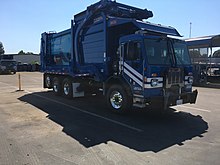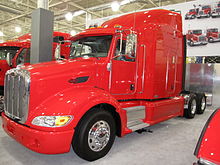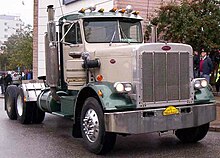This is a list of vehicles manufactured by the American truck manufacturer Peterbilt since its 1939 founding.
Current
| Current Peterbilt vehicles | |||
|---|---|---|---|
| Model name | Production | Vehicle type | Notes |
220 |
1998-2007
2011–present |
medium-duty (Class 7)
COE, low cab forward |
Shares DAF LF cab with Kenworth K370
Built on frame of 330 conventional. |
| 365 367  |
2007–present | severe-service/vocational (Class 8) | 365: 115-inch BBC, replaced 357
367: 123-inch BBC, replaced 378 Both models offered in set-back or set-forward front axle configuration |
389 |
2006–2024 | on-highway (Class 8) | Replaced 379, with redesigned headlamps, fenders, and trim.
131-inch BBC (longest-produced by Peterbilt). Offered in Australia (through 3rd-party conversion to right-hand drive) |
| 389X | 2006−2024 | on-highway (Class 8) | Is also called Peterbilt 389 Pride and class
Replaced 379, with redesigned headlamps, fenders, and trim. Luxurious and Modified version of the 389 131-inch BBC (longest-produced by Peterbilt). Offered in Australia (through 3rd-party conversion to right-hand drive) |
520 |
2016–present | vocational
COE, low cab forward |
Replaced 320, for refuse collection applications
Redesigned to accommodate PACCAR engines and modernized interior |
| 535
536 537 548 |
2021–present | 535/536: Class 5/6
537/548: Class 7/8 |
Introduces the 535, 536, 537, and 548 with the connected windshield and having a 567 Cab.
535/536: The non-CDL trucks feature all-new self-closing doors with larger windows for increased visibility, three opening positions, and a triple seal. 537/548: feature two hood options: a vocational three-piece Metton® hood featuring a stationary grille with full through rail, and a three-piece SMC aero hood for maximum visibility. 535/536: 107 of 109-inch BBC 537/548: unknown Offered (535/536) as composite and steel bumpers as well as multiple options of fuel and DEF tanks. Offered (537/548) as both hood options can use a variety of vocational and FEPTO bumpers to fit different applications. |
| 567 | 2015–present | severe-service/vocational (Class 8) | Shares cab with 579, headlights of 389
115 or 121-inch BBC Offered in set-back or set-forward front axle configurations |
579 |
2012–present | on-highway (Class 8) | Replaced 587 as newest Peterbilt "aerodynamic" conventional
123-inch BBC, 83-inch cab width |
Retired (1980 to date)
| Retired Peterbilt vehicles | |||
|---|---|---|---|
| Model name | Production | Vehicle type | Notes |
| Mid-Ranger (200) | 1987-1999 | medium-duty (Class 5-7)
COE, low cab forward |
Version of the Volkswagen LT, using MAN G90 (wide-body) cab, produced in Brazil.
Sold with American-market drivetrain |
| 210 | 1998-2007
2011-??? |
medium-duty (Class 6)
COE, low cab forward |
Adaptation of DAF LF, shared with Kenworth
Second generation built on 325 frame 26,000-pound GVWR; non-CDL applications |
320 |
1987-2018 | COE, low cab forward | Replaced 310 (and Kenworth Hustler)
Added right-hand stand-up drive to cab |
| 335
340 |
????-2009 | 335: Class 7
340: Class 7/8 |
It is the older models of the 337 and 348 |
| 349 | 1980-1987 | on-highway (Class 8) | Light-GVWR highway tractor.
Slightly sloped hood, wider grille than 348; also available with set-back front axle. |
357 |
1986-??? | on-highway (Class 8) | Severe-service/vocational model line.
Similar in configuration to 378, but with heavier-duty chassis 111-inch through 123-inch BBC; set-back and set-forward front axles Flat-fender hood (similar to 353) offered as an option, along with front PTO |
362 |
1981-2005 | on-highway (Class 8)
Cabover/COE |
Replaced Model 352 COE; visually similar, all-new design.
54-inch to 110-inch BBC; multiple axle configurations (including tandem-steer) 362E (introduced c.1990) with greater interior room, easier entry |
| 372 | 1988-1994 | on-highway (Class 8)
Cabover/COE |
Last all-new Peterbilt COE design
Developed to improve aerodynamics over 362 (sharing its doors and grille); received over 11 MPG in development testing Intended for team operation; raised-roof sleeper integrated into large roof fairing; rounded nose fairing raised for engine access. Unusual appearance created many nicknames, including "Winnebago", "football helmet", or "Darth Vader" (or less kind). |
| 375 | 1987-2005 | on-highway (Class 7/8) | First Peterbilt aerodynamic conventional; similar in concept to the Kenworth T600 and is the daycab version of the Peterbilt 377 that carry's lighter loads
Fiberglass hood sloped similar to 349, with large fenders (incorporating headlamps and turn signals) 120-inch BBC (set-back front axle), 122-inch BBC (set-forward front axle) Directly replaced by 120-inch 385 (along with 387) |
377 |
1986-2000 | on-highway (Class 8) | First Peterbilt aerodynamic conventional; similar in concept to the Kenworth T600
Fiberglass hood sloped similar to 349, with large fenders (incorporating headlamps and turn signals) 120-inch BBC (set-back front axle), 122-inch BBC (set-forward front axle) Directly replaced by 120-inch 385 (along with 387) |
378 |
1986-2007 | on-highway (Class 8) | Replaced Model 348
Built for multiple applications, including vocational and on-highway. Similar to 379 (sharing its 119-inch BBC); a higher-mounted cab added a sloped hood design to the model line. Multiple axle configurations; set-forward and set-back front axles |
379 |
1987-2007 | on-highway (Class 8) | Replaced Model 359 as flagship Peterbilt conventional.
119-inch and 127-inch BBC In design change from 359, turn signals moved from fenders to (rectangular) headlamps Replaced by 389 in 2007 |
| 379X | 2003–2005 | on-highway (Class 8) | 379X was a special edition of the 379. there were roughly 1-2000 of them produced.
119-inch and 127-inch BBC In design change from 359, turn signals moved from fenders to (rectangular) headlamps Replaced by 389 in 2007 |
384 |
2007-??? | on-highway (Class 8) | 116-inch BBC version of 386 |
385 |
1996-2007 | on-highway (Class 8) | Developed to compete with Freightliner FLD 112
Similar in appearance to 377 (different hood slope) 112-inch BBC; set-back front axle standard 120-inch BBC replaced Model 377 |
386 |
2005-2015 | on-highway (Class 8) | Combined aerodynamic hood design of 387 with standard Peterbilt cab design (except external air cleaners)
126-inch BBC |
387 |
1999-2010 | on-highway (Class 8) | Indirect replacement for Model 377; first Peterbilt aerodynamic conventional with "wide-body" cab
Shares cab structure with Kenworth T2000; built on Peterbilt frame, 387 has different hood, roof fairing, and interior design. Produced as day cab, mid-roof sleeper, and raised-roof sleeper. |
388  |
2006-2015 | on-highway (Class 8) | 123-inch BBC configuration of Model 389, replacing 119-inch version of 379
Renamed as 123-inch version of 389 in 2015 |
397 |
1980, 1982 | Conventional (Class 9) | Largest Peterbilt model line, 2 examples built
up to 500,000-pound weight capacity, with up to 600 hp engines |
587 |
2010-2016 | on-highway (Class 8) | Replaced 387 as Peterbilt "wide-body" aerodynamic conventional (similar to Kenworth T700)
Redesigned hoodline to improve visibility and lighting. Produced as day cab, mid-roof sleeper, and raised-roof sleeper. |
| 325 | 2007–2021 | medium-duty (Class 5) | Built for non-CDL applications |
| 330 337 348  |
2007–2021 (330)
2009–2021 (337,348) |
medium-duty
330: Class 6 337: Class 7 348: Class 7/8 |
Introduces single-piece windshield to medium-duty trucks
330: Built for non-CDL applications 337: truck or semitractor, replaces 335 348: vocational applications, replaces 340 |
Historic (1980 & prior)
Before 1981, model designations started with 2 for single-drive (and tag axle) vehicles, and 3 for dual-drive vehicles. This distinction gradually was phased out in the late 1970s.
| Model name | Production | Vehicle type | Notes |
|---|---|---|---|
| 260
334 |
1939-1941 | Conventional | First Peterbilt model line, evolved from a Fageol design.
Logging trucks sold to the public 260: chain drive 334: dual drive axles |
| 270
334 345 |
1941-1949 | Conventional | On-highway truck
Last model line developed by T.A. Peterman |
| 354
355 364 |
1941-1949 | Conventional | Heavy-duty truck
28 Model 364s produced for the US Navy (1942). |
| 280
350 |
1949-1957 | Conventional
Cabover/COE (1949-1953) |
On-highway truck, nicknamed the "Iron-nose" truck
Butterfly-type hood with cycle-style fenders. Vertical shutters on grille COE version produced, nicknamed "bubble-nose" style (short hood) |
281
351 |
1954-1976 | Conventional | On-highway truck, nicknamed the "narrow-nose" truck
First model line introduced with red Peterbilt emblem (at launch) Butterfly-type hood with cycle-style fenders. Horizontal shutters on grille Set-back front axle option introduced in 1971 (later becoming 353) NASA owned 4 such truck but retired two of them, R-13 and R-15. Due to problems with their cryogenic tanks. |
| 281
351 |
1954-1958 | Cabover/COE | First Peterbilt COE model line developed with its own cab
Shares doors with 281/351 conventional |
| 282
352 352H |
1959-1980 | Cabover/COE | First tilt-cab COE, developed as distinct model line; first UniLite cab
Nicknamed the "Pacemaker" in 1969, coinciding with an update 54-inch to 110-inch BBC 352H is a raised-cab version, fitted with a larger radiator; produced from 1975-1980 |
| 288
358 |
1965-1976 | Conventional | Variant of 281/351 with a tilting hood, first Peterbilt equipped with a design. Fiberglass hood introduced in 1972.
First Peterbilt model line with current hood ornament design |
| 289
348 (1967-1987) (Not the New 348) 353 359 359X |
1967-1987 | Conventional | Replaced 281/351
Distinguished by wider grille for larger radiator The 353 is the heavy duty version of the 359 The 359X is the limited edition version of the 359, only 2000 of them were made Replaced by 379 |
| CB300 | c.1975-1978 | COE, low cab forward | First Peterbilt truck designed for refuse applications
Designed and produced jointly between Peterbilt and Kenworth |
| 310
319 |
1978-1986 | COE, low cab forward | Replaced CB300, designed for refuse applications
Model 319 used rear PTO and rear lift axle with steering capability |
| 351L | Conventional | Severe-service variant of 351 designed specifically for logging
Flat diamond-plate fenders | |
| 341 | 1954-1972 | Conventional | Short-hood variant of the 351 designed for vocational applications
Replaced by 348 |
| 346 | 1972-1975 | Conventional (Class 9) | Designed for vocational applications, with a (highly) set-back front axle
Only 10 produced, second-rarest model line |
| 348 | 1970-1986 | Conventional | Designed for cement mixers and dump trucks
First Peterbilt with a sloped fiberglass hood |
| 353 | 1973-1987 | Conventional | Designed for construction applications, flat steel fenders
Used grille of 359 (radiator) with butterfly hood Replaced 341 and 351 vocational trucks |
| 381 | c.1975 | Conventional | Severe-service truck, 6x6 drive configuration
Flat fenders, butterfly hood; lower, narrower radiator than 383 |
| 383 | c. 1966-1979 | Conventional | Severe-service truck, 6x6 drive configuration
Flat fenders extend to back of cab |
| 387 | 1976-1987 | Conventional (Class 9) | Severe-service truck, originally developed for coal transportation
Later developed for multiple applications Model number reused in 1999 (only model line to do so) |
| 391 | c.1977 | Conventional (Class 9) | Logging truck, similar in design to the 387; only one built
Built using a Kenworth frame and a Peterbilt body, current whereabouts unknown |
Sleepers
In the 1960s and 1970s, 30" and 36" sleepers were available. If a buyer wanted a larger sleeper, Peterbilt worked with Mercury Sleepers for 40", 60", and custom sized sleepers. Mercury would paint the sleeper to match the factory paint or the sleeper came with polished quilted aluminum. In 1978, Peterbilt's engineers were tasked with making a bigger sleeper. They designed the 63" sleeper with rounded doors and a walk-through from the cab. The sleeper debuted on a 359-127" and can be seen in the 1978 brochure "Best in Class". This truck also featured the first set of rectangular headlamps. The first raised roof (high cube) sleeper was on a 359 in 1986 and with changes (no right hand forward door) carried through to the 379 family. In 1994, the Unibilt sleeper debuted with air-ride suspension for the cab and sleeper with a large cab to sleeper opening. The Unibilt sleeper suspension had a one piece shock/air bag mount system from 1994 to 2006, until Peterbilt redesigned the suspension system for the 2007 model year, making the shock and air bag system on separate brackets. The Unibilt cab/sleeper option allowed for the sleeper to be removed for a daycab conversion. The UltraSleeper was Peterbilt's largest and most luxurious. At 70" long, it featured a right-hand access door, table, closet and a small "wet closet" accessible from the driver's side to store boots, gloves, and other 'damp' items. The last UltraSleeper was built in 2005
References
- ^ Nunlist, Tom; Editor, Associate. "Peterbilt 210 and 220 Low COE to Return Next Year". www.truckinginfo.com. Retrieved November 18, 2019.
{{cite web}}:|last2=has generic name (help) - ^ Staff. "Peterbilt Enhances Medium-duty Models 210, 220". www.truckinginfo.com. Retrieved November 18, 2019.
- "2007 Peterbilt 365 @ Top Speed". www.topspeed.com. 2 April 2012. Retrieved November 18, 2019.
- "PETERBILT REINTRODUCES MODEL 389 PRIDE & CLASS PACKAGE | Peterbilt".
- Staff. "Peterbilt Unveils Model 520 for Refuse Fleets". www.truckinginfo.com. Retrieved November 18, 2019.
- ^ Staff. "Peterbilt Showcases Model 567". www.truckinginfo.com. Retrieved November 18, 2019.
- ^ Truckinginfo Staff. "Peterbilt Introduces 'New From the Ground Up' Model 579". www.truckinginfo.com. Retrieved November 18, 2019.
- "From LT to Worker - Volkswagen's Versatile, Long-lasting "LT" Cab". BigMackTrucks.com. 29 May 2014. Retrieved November 18, 2019.
- . Peterbilt.
{{cite web}}: Check|url=value (help) - ^ Sandhills Publishing Company. "Peterbilt History | Peterbilt of Louisiana | New and used Peterbilt truck dealer". www.peteoflouisiana.com. Retrieved November 21, 2019.
- "Peterbilt Spotters Guide - Pre 1980 Conventionals". www.timstrucks.com. Retrieved November 19, 2019.
- "Tims Trucks PB2". www.timstrucks.com. Retrieved November 20, 2019.
- "Peterbilt Expands Its 357 Vocational Series". Construction Equipment. 28 September 2010. Retrieved November 22, 2019.
- ^ says, Yusef Transit (June 17, 2019). "The History of Peterbilt Trucks". Allstate Peterbilt Group. Retrieved November 18, 2019.
- ^ "Tims Trucks PB9". www.timstrucks.com. Retrieved November 20, 2019.
- "Peterbilt". Peterbilt.
- "Peterbilt". peterbilt.com. Retrieved March 8, 2019.
- "Peterbilt Spotters Guide - 386 and 384". www.timstrucks.com. Retrieved November 21, 2019.
- "Photo: 1234 | Peterbilt 397 album | Mackinac359". Fotki - www.fotki.com. Retrieved 2021-11-06.
- "Peterbilt Motors Company - #TBT to 1982 with this purpose-built Model 397 heavy unit. #Peterbilt power. | Facebook". www.facebook.com. Retrieved 2021-11-06.
- http://timstrucks.site.aplus.net/397brchr.jpg.
{{cite web}}: Missing or empty|title=(help) - "Peterbilt launches Model 587". www.overdriveonline.com. 24 March 2010. Retrieved November 21, 2019.
- "Model 325 | Peterbilt". www.peterbilt.com. Retrieved November 18, 2019.
- "Peterbilt introduces Model 325 for Class 5 market". www.ccjdigital.com. 26 June 2007. Retrieved November 18, 2019.
- "Model 330 | Peterbilt". www.peterbilt.com. Retrieved November 18, 2019.
- "Model 337 | Peterbilt". www.peterbilt.com. Retrieved November 18, 2019.
- "Heritage | Peterbilt". www.peterbilt.com. Retrieved November 18, 2019.
- "Final season one episode of American Trucker on Speed Channel this Thursday". www.overdriveonline.com. 7 June 2011. Retrieved 2020-10-01.
- . Peterbilt. Retrieved March 6, 2019.
{{cite web}}: Check|url=value (help) - .
{{cite web}}: Check|url=value (help) - ^ "Peterbilt Spotters Guide - Pre 1980 Conventionals". www.timstrucks.com. Retrieved November 19, 2019.
- "Peterbilt.com". Peterbilt.com. Retrieved March 5, 2019.